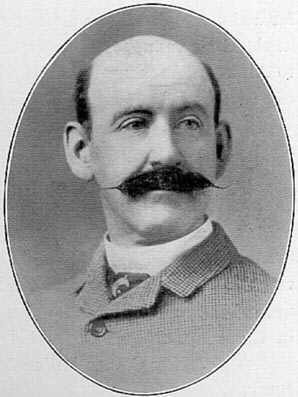With Dr. Scott G. Birdseye

Scott Birdseye is a professor at the world-renown Botham
University in Himmot, Accadia. Throughout his life he has
traveled to various countries, written various things and
seen up to seven different types of brickwork. He does not
enjoy mushrooms; both the flavor and the texture; in his
opinion, are entire unappetizing.
On the Subject of Forts and Fort-Like-Things
Just as weapons can be divided into two distinct classes: shock and missile, so can military tactics be divided into two different categories: the light, fast and maneuverable and the heavily armored yet. There are abundant examples in the history of warfare of instances wherein different categories of weapon or soldier were able to claim supremacy of the field, whether shock troops such as the Medieval knight, missile troops such as the longbow, or fast, light troops such as guerrilla fighters. Each specific attribute provides both strengths and weaknesses, as is the case with heavily armored yet slow troops, an example of the sacrifice of mobility for protection. The ultimate example of this sacrifice is the permanent fortification.
Completely lacking mobility, permanent fortifications, though their imposing strength could prove themselves nearly impossible to capture, producing a system of combat dominated by the prolonged siege. Although the development of artillery caused the decline of the castle system, it also generated the invention of new forms of fortification, typified by the works of French engineer Vauban, whose contributions to the art of defensive construction and siege-craft would dominate that field for nearly three hundred years.
The system of permanent fortifications for military defense is as old as recorded civilization. The earliest stone wall structures of Asia Minor and the Southern Caucuses slowly developed over thousands of years into the architectural marvels of the massive walled cities of Classical Greece and Rome. Forming the basis of the early Medieval permanent fortification, the city wall concept dominated the field of strategic defenses until the later rise of the Norman military concepts. The Franks and Normans were the first group in Europe to modify the non-permanent wooden mot and bailey design into the permanent stone castle concept, which was a direct response to Viking coastal raids. Soon after their development, castles began to dominate the military landscape of Europe, which was, in the Middle Ages, under constant threat of internal war and external attacks by Vikings, Mongols, Muslims and others.
With imposing size and simple basic design, the castle was popular with Medieval nobles. Castle walls were generally about fifteen to twenty feet thick and used height as a defense against scaling and mining, two of the prominent siege tactics of the time. The strength of castles depended not only on their size, but also on the relative weakness of the available siege weapons. Economics also added to the defense strength of castles, as prolonged sieges were often too expensive for Medieval feudal lords, thus insuring the near invulnerability of castle defenses.

While castle based defense dominated the Medieval world, developments of the High Middle Ages reduced the invulnerability of castles, and forced defensive strategists to adopt new methods of permanent fortification. The introduction of gunpowder weapons to Europe represented one of the most significant events in the history of the Western world, as it brought about the restructuring of the military and political systems of the continent. Distinctly tied to these changes was the revolution brought about in fortification architecture in response to gunpowder. The early to mid Fourteenth Century witnessed the introduction of gunpowder technology into Europe.
The first recorded use of artillery as a siege-craft weapon occurred in 1362, although the outcome of the siege is unknown. Fifteen years later, however, the Duke of Burgundy besieged Odkruik using over one hundred cannon and succeeded in breaching the castle’s walls. The effectiveness of early cannon in destroying castle walls was not due to the greater force of the projectiles, but instead to the straight, rather than arched, trajectory which allowed the missiles to be aimed directly at specific weaknesses. Primitive artillery did not provide greater force than traditional missile based siege weapons, but rather used the force in a more effective manner, thus destroying the previous near-invulnerability of castle defenses.
The full capability of cannon against traditional defense systems was blatantly illustrated for the first time in the year 1453 when the Byzantine city of Constantinople fell to an Ottoman army equipped with the most modern weapons then available, including a twenty-five inch cannon which could fire projectiles weighing more than half a ton. Situated on the Bosporus, Constantinople not only provided control of the Black Sea trade routes, but was also seen as the most important defensive position against Ottoman expansion into Europe. As the center of the Orthodox Church, Constantinople was also one of the most important cities in Christendom. While other cities and castles in Europe had suffered attacks and successful sieges by artillery equipped armies, non were as strategically and psychologically important as Constantinople.
The loss of Constantinople to the armies of Mahomet II opened the Balkans, Greece, Italy and Austria to direct Ottoman aggression and threatened Central and Western Europe with foreign invasion, reawakening the fear rousted by Viking and Mongol invaders in earlier eras. Thus, the conquest of Constantinople instigated a massive build-up of new work, in both theory and practice, on ways to improve permanent fortification defenses throughout Europe.
Fortress construction was expensive, and many Europeans were unwilling to abandon traditional castles. Nobles often utilized low-cost modification of existing structures in favor of exhausting their treasuries in the undertaking new projects. Platforms for defensive cannon were built, often on the remnants of razed towers and rocks and dirt were pushed up against walls to increase strength against bombardment, in a manner which became known as rampiring. Defensive artillery, however, was of little use in the hurriedly modified castles, as light cannon lacked the range to bombard enemy positions and the recoil of heavy cannon endangered the stability of the castle foundation. In battle, these modifications, which were often jury-rigged and hastily erected, did not stand up well to artillery bombardment, as illustrated by French King Charles VIII’s invasion of Italy in 1495. During the fighting between French and Spanish forces in Italy, several Italian castles were successfully besieged, prompting the Italians to undertake a major defensive buildup.

Engineers in Pisa, Venice and Naples such as Antonio de Sangallo and Michele di Sanmichel developed entirely new concepts in defensive fortification. Pisan Style fortresses, as they became known, emerged as a direct result of the ferocity and effectiveness of French artillery siege-craft. Among the advancements created within the Pisan Style were a system of parallel ditches surrounding both sides of the main wall, a design which mean that, even if an attacker managed to destroy a portion of the wall, they could not move a mass of troops through the gap. The walls of the Pisan Style fortress were sunk, so as to provide little target area for straight trajectory artillery, and the walls were defined by short wedge shaped towers called bastions which were placed in symmetric and geometrically precise positions to provide overlapping fields of fire. Thus, if an enemy reached the wall, they would find themselves, irrespective of their point of attack, in the range of defensive fire from at least two bastions. Roundels, short stone platforms designed for placement of defensive artillery, replaced traditional towers in the Pisan design.
Traditional castle walls, which were tall and thin, were replaced by low, thick walls, the thickness of which could often reach up to sixty or seventy feet. Outworks were also developed with the Pisan Style, for the purpose of preventing enemy artillery from gaining access to positions outside the walls during a siege.
These new designs were put to the test in 1502 when Louis XII, successor of Charles VIII, invaded Italy in response to the civil war in Naples. In 1504, the city of Pisa was besieged by a combined French and Italian army. The French artillery inflicted a massive bombardment on the cities defenses, which had been rebuilt according to the new advancements in fortification technique. The failed attack forced the French into making peace with the Pisa and resulted eventually in French withdrawal from Italy and leaving Naples under Spanish control. After the success of the Pisan Style, the peculiar yet effective star-shaped fortress design spread throughout Europe in the latter half of the Sixteenth Century.
Gonzalo de Cordoba, Spanish military commander during the civil war in Naples, recognized the effectiveness of the new fortification technologies and the Pisan engineering advances were readily adopted by Spain, directly contributing to Spanish military supremacy in Europe during the Sixteenth Century.
Although the innovative star-shaped fortification of post-Medieval Europe saw its origins in Italy, the design is often incorrectly attributed to French strategic theorist and military commander Sebastian le Prestre de Vauban. Working for Louis XIV at the height of the French monarchy’s power, Vauban, as a military advisor, conducted and oversaw many of the French army’s siege battles. It was in the course of these operations that Vauban first began to explore the engineering principals of defensive fortification. After extensive study and observation, Vauban drew basic designs for over one hundred fortresses and port works. As siege warfare was the dominant form of combat in Europe at the time, Vauban wrote countless treatises on fortification design and, through letters, consulted the king on the subject.
Throughout these early works, Vauban discussed neither specific aspects of military engineering nor precise elements of strategy or tactics. Instead, Vauban reiterated and supplemented the concepts first envisioned by early Seventeenth Century theoretical engineer Blaise de Pagan, who, in his Les Fortifications du Compte de Pagan, promoted the use of Enlightenment science and mathematics in tactical and strategic military design.
Despite the fact that Vauban was not the principal developer of the post-Medieval fortification technologies, it was he who, through his expansion upon the basic concepts of the design, enabled the innovative engineering concepts to be used to their greatest effect.

Although Vauban never laid down exact rules or laws governing defensive science, his modifications and improvements of the early works produced a set of principals by which he forever changed the construction of defense works and the battle tactics which revolved around the siege and protection of such works. Vauban’s innovations of defensive technology are divided into three Systems, each of which, at its own specific time, dominated the construction of fortifications in Europe.
The First System used Pagan’s ideas in concert with the modernization techniques of the Pisan style. While Vauban retained the polygon, or star-shaped, design, he improved greatly in the area of the fortresses’ outworks. Trenches were augmented by sloping earth called glacis, which provided better protection against small-arms fire. The counterscarp, or main walls, of the fortress were also enhanced by larger earthen glacis to provide greater protection from straight trajectory artillery attack than had been provided by the earlier simpler sunk design. Extension of the outworks also made assault mining almost impossible, as the distance from the fortress to the enemy position was increased, in some cases, to a mile or more.
The hallmark of the Second System was the enlargement and detachment of the bastions. By separating the bastions from the main unit of the fortress the range of defensive cannon was extended and the overlapping of the fields of fire was greatly increased, making close assault of the fortress even more dangerous for the enemy army. The Third System, of which there is only one example, was only a slight modification of the Second. Changes within the Third System included the alteration of angle of the bastions, which was made more acute, modifying of the shape from a solid wedge into a more pointed spike, further increasing the overlap of defensive fire. The overall size of the fortress was also increased, and underground tunnels were extended and enlarged to increase the ease of supply and reinforcement within the structure.
The success of Vauban’s modifications of the preeminent fortress design of the time resulted once again in the near invulnerability of defensive works on the battle field. The strength of the new fortifications is fully illustrated by the Spanish assault of Santhia, where a newly constructed fort survived several thousand artillery hits with its walls still intact to a high enough degree to repel the attack.

Field commanders lacking in arms or who had been outmaneuvered had only to retreat to a fortress position, consequently, siege warfare became more common than battles in the field. Thus, at the bequest of the Crown, who sought to ensure French military supremacy in Europe, Vauban set about to create complete and precise guidelines for fortress assault.
Using scientific principals, in the manner of Pagan’s works, Vauban helped to develop what became known as the Scientific Siege. New tactics set forth by Vauban consisted of a series of predetermined movements and advancements, by which were detailed the positions of all assault units and bombardment artillery groupings. The attack of the fortress, according to Vauban’s works, was conducted by means of a complicated and precise preordained timetable. Vauban dictated that forty-eight days should be the exact length of a well directed siege. The first action of the siege tactics which Vauban pioneered involved the disruption and severing of supply routes to the fortress, prior to actual assault. Smaller field fortifications would then be built, often over a mile away from the fortress, for the placement of heavy assault guns. Under the cover of massive artillery bombardment designed to check defensive fire, infantry and engineers would construct a series of parallel zigzag trenches. The zigzag arrangement was utilized to prevent defensive small-arms fire from penetrating the length of the trench.
When the assault trenches had reached the outer limits of the defensive fortifications, smaller artillery pieces were moves into close proximity to the walls in order to produce a breach, while larger artillery in the rear changed from straight trajectory to arced fire in order to lay down fire on top of, rather than into the side of, the fortress. When the walls were breached, infantry would directly assault the fortress, although it was often more beneficial for both sides, if the fortress were surrendered before the final assault. Thus, most sieges of the period ended with a truce rather than a pitched battle.
The scientific principals set up by Vauban for conduct of siege warfare became very well known throughout Europe, and over time, sieges became less about fighting and more about show and display of power. With precise timetables for assault, defensive commanders had only to wait until the final moment to honorably surrender. Louis XIV held elaborate parties at the expected final moments of sieges and assault gradually evolved from a battle into a formality of warfare, given over to gentlemanly displays of honor and refined courtesy. Observing the gaiety and ceremony which began to dominate the conduct of siege-craft, Horace Walpole, Earl of Oxford complained that “War has become so peaceful that when a city is besieged today and falls, the women inside can’t even hope for the benefits of a good rape.”
Despite the protests of Oxford and others of the same mindset, the advancements brought about Vauban’s defensive and offensive tactics caused warfare in the Seventeenth and Eighteenth Centuries to develop from a ruthless contest of arms into an elaborate game of check and evasion.
This development is likely the result of Vauban’s own work. It is peculiar that Vauban, the day’s leading master of defensive engineering, was also the chief architect of the premier fortification assault tactics. The cordiality which began to dominate siege-craft was directly due to the inherent lack of advantage afforded both the offensive and the defense in the field of siege warfare. Artillery, which had brought down the rule of the castle system, was the central weapon of the assault forces, however, the growing complexity and effectiveness of artillery weapons was equally matched by continuing improvements to fortification design.

In the early days of the Vauban assault tactics, before battle gave way to pageantry and ceremony, prolonged sieges often became pitched trench battles, as defenders emerged, under cover of artillery, from their fortified positions into their own forward ditches to use small arms fire to repel enemy infantry and engineers. Thus, the system of trench warfare was born, as elements of defensive and offensive forces skirmished on the outworks of fortresses for control of tactically important positions. With such close-in, bloody fighting dominating the siege battle, it can be clearly seen why commanders would prefer honorable surrender, particularly in a time when highly trained soldiers were thought too valuable to risk losing unless victory could be completely ensured. As neither side could find a clear advantage, siege warfare became a choice between a prolonged, deadly, and possibly futile struggle or a martial formality which ensured survival of both the army and the fortress.
While in the following centuries, field tactics were modified, advanced and improved upon countless times, the methods of siege warfare and the tactics for fortification defense underwent no such revolutionary progression. Thus, at the beginning of the Twentieth Century, when new technological developments such as the repeating rifle, brought to an abrupt end the domination of the innovative field tactics which had been wrought by the Wars of Napoleon and the U.S. Civil War, among others, the armies of Europe were forced to rely once again upon the tactical systems developed by Vauban. The static tactics of trench warfare, envisioned by Vabaun in the Seventeenth Century, were once again brought to bear in the First World War.
The result of this archaic approach to warfare was a stagnant and bloody form of battle, a perverse, yet direct descendant of the military style created by Marshall Sebastian le Prestre de Vauban nearly three hundred years earlier, an sinister display of the importance and longevity of the man who was, at one point, the world’s foremost military engineer.

Neat, tripps. I was looking for tips on siege warfare; didn’t realize you guys were into this kind of thing. 🙂
Cheers,
Guapo
Did you just happen to find us in a search engine?
this is a very intresting page i just got finished reading
Which portion did you find most interesting?
I like your blog here, thanks to you you’ve got helped me out greatly spread the love.
shares use a perfect web-site decent Gives thank you for the hard work to guide everyone